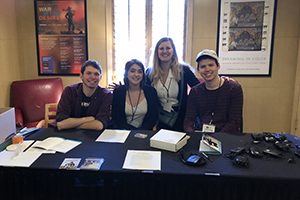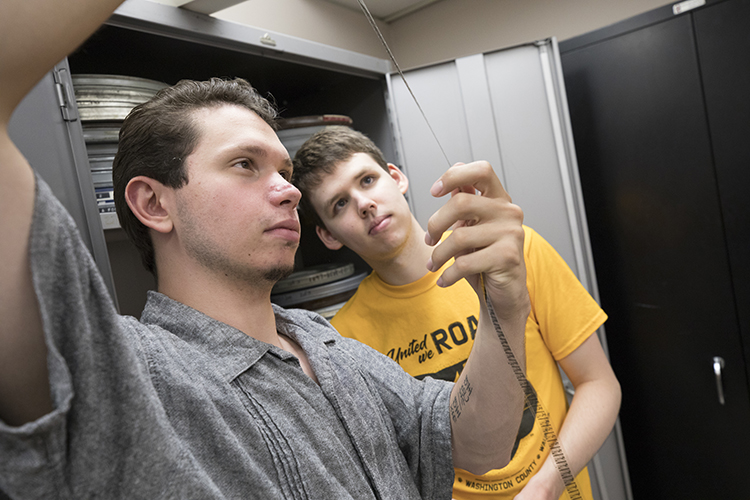Two UWM students, Hugo Ljungbäck and Christian Balistreri, are spearheading a project to preserve and restore a long-forgotten 16-millimeter film archive in Curtin Hall.
“We are reviving history,” Ljungbäck said.
They are supervised by Tami Williams, an English and film studies associate professor whose academic expertise includes early cinema history.
The Patricia Mellencamp collection, named after one of the founders of the film studies program at UWM, contains over 90 films originally screened in film, English and art history classes in the 1970s and ‘80s.
“Hugo has been researching the history of our film studies program and Pat’s foundational role as a first-generation film studies scholar,” Williams said.

The UWM film studies program was one of the first programs of its kind in the 1970s, due in large part to Mellencamp.
There is a wide selection of the types of films in the collection. Marquette University gave UWM 60 old film reels, mostly educational or instructional films, last year. These films provide a rare opportunity for student research since the distribution and preservation of institutional films have been poorly documented.
There are many hidden gems found in the film archive from the early days of cinema, including Georges Méliès 1902 classic “A Trip to the Moon,” several Charlie Chaplin movies and a few Alfred Hitchcock films.
“We have three copies of ‘Citizen Kane,’ and I think we all have this kind of crazy ambition or dream to project them all at the same time,” Ljungbäck said.
Auspicious beginnings
Balistreri first approached Williams two years ago with an interest in doing more film archiving with the unused and untouched collection at UWM. He was able to get SURF funding through the Office of Undergraduate Research to start digging into the film reels, first cataloging the collection and noting their condition.
“For a good year and a half, it was in my hands,” said Balistreri.
Williams cleared space in her office for him to work.
Then the Office of Undergraduate Research reached out to Williams about Ljungbäck becoming another SURF-sponsored researcher because of their mutual interests.
“The 16 mm archive was not the project that we were originally supposed to be working on, but when Marquette donated their collection that became my primary focus,” Ljungbäck said.
Together, the films from Marquette University and the Patricia Mellencamp collection formed the Film Studies Moving Image Archive. Along with the archive, a few students created a student organization called the Moving Image Society to create awareness of the archive on campus and through the film studies program.
A home of its own
Now that the film archive had a name, it needed a home.
“Tami suggested we get in touch with C21 (Center for 21st Century Studies) to possibly host the collection,” Ljungbäck said.
The Center for 21st Century Studies agreed to host the archive in an empty office space. The space is small, with a white sheet of paper on a metal cabinet as the projection screen, but Balistreri and Ljungbäck finally had space to themselves to continue their work.
A typical day in the office includes them manually inspecting the film for damage or splices, in case the film had been split and taped back together. After that, the film is projected and watched all the way through to see if there are any spots or discoloration.
An eye on the future
In June, Balistreri and Ljungbäck, with film studies student Haley Richards, traveled to Rochester, New York, for the Domitor 2018 conference at the George Eastman Museum.

“It is one of the most important archives in the United States for nitrate film,” said Williams, who is president of Domitor, the International Society for the Study of Early Cinema.
A grant from the UWM English Department paid for their registration, but the three students paid for transportation and a hotel to meet some of the foremost early cinema scholars and archivists from around the world, including Brazil, Turkey, France and Sweden.
“My colleagues couldn’t believe it when I told them my students are reviving our 16 mm collection,” Williams said.
The three students impressed the George Eastman Museum staff so much, they were invited to tour the archival facilities.
Taking what they’ve learned in Rochester, the students are working to improve the storage conditions of UWM’s own collection. The next plan is the “Save the Archives” film festival on Sept. 20, which will honor Mellencamp’s work and collection. The screening will feature 24 short films from around the world and conclude with two archival prints from the Mellencamp Collection, accompanied by live music. The screening will benefit the archive and the students’ preservation efforts, so that necessary supplies can be purchased.
“Our festival is an effort to let people know about the archive,” Ljungbäck said, “If you’re interested, we exist, and there are ways to get involved.”







